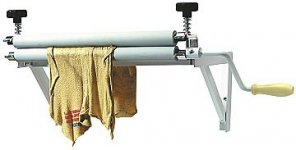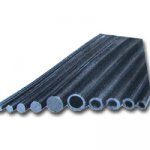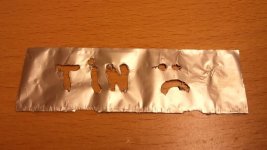I am in the process of finishing a DIY Apogee (Duetta Signature) like speaker. Right now I am making a corrugator tool for the bass ribbon.
What are you using for the corrugating roller?
Well this is what I have in mind. I am going to modify this machine you see on the picture to handle much wider rollers. I am throwing away these rollers and they are subtituted with the threaded steel rod (x2) that you see on the picture. On these two rods (16mm) my intension is to use Epoxy glue and to fasten a lot of these carbonfiber rods that you see on the picture. They are 2mm by 600mm. I have bought 40 of them and they sell them in every model airplane shop. They have the right stiffness and they have a very even surface and they are completely circular in shape. I believe that these material should be easily available to most people that have an interest.
Attachments
Well this is what I have in mind. I am going to modify this machine you see on the picture to handle much wider rollers. I am throwing away these rollers and they are subtituted with the threaded steel rod (x2) that you see on the picture. /QUOTE]
The reason I asked is one day I want to make new bass panels for my Scintillas. The mid's and tweeters I've already made a roller for, and they turned out excellent.
I had a similar idea, but joining rods will leave imperfections. Also the rod would have to be used along the length of the panel and would never turn out 100% straight to make a good roller. What a person needs is an extruded ribbed tube of at least and inch in diameter as it will be strong and consistent. I used to work for a firetruck manufacturing company, and the aluminum handrail tubing is exactly what would be perfect, so that is what I am going to soon purchase and then make a roller system.
I'm not sure when I'll do that as my bass panels are still in pretty good condition, but I do want to do this at some point and will post results.
This looks like something similar : The Scintillating Apogee - Hi-Fi News September 1985
This looks like something similar : The Scintillating Apogee - Hi-Fi News September 1985
Exactly, that is what I want to achieve. If you want to see what a nude Scintilla looks like, here are some shots of mine apart http://s171.photobucket.com/albums/u299/Saturn599/Apogee Scintilla/
Last edited:
Here is a handwritten procedure for tuning of Apogee Diva. If there is someone interested, here it is:
https://picasaweb.google.com/tsundsd/October292012?authkey=Gv1sRgCPv0qfqR9oKrAw#5804518306051868834
Don´t remember where I got this from, but it was probably the old Audioworld Straightwire Apogee forum.
https://picasaweb.google.com/tsundsd/October292012?authkey=Gv1sRgCPv0qfqR9oKrAw#5804518306051868834
Don´t remember where I got this from, but it was probably the old Audioworld Straightwire Apogee forum.
Last edited:
Photo of my roller. The pattern is a little different, but I'm going to give this one a try sometime as comparison to the original which has more pleats
http://i171.photobucket.com/albums/u299/Saturn599/Apogee Scintilla/Ribbon Roller/MRTWroller.jpg
http://i171.photobucket.com/albums/u299/Saturn599/Apogee Scintilla/Ribbon Roller/MRTWroller.jpg
I'm very impressed by the ingenuity posters have shown when devising ways to corrugate, or otherwise pattern, their ribbons. My admittedly limited research on the subject has uncovered more evidence suggesting the corrugation does not help than evidence that it does. I certainly don't want to devalue the contributions of those who have developed nice ways to pattern their ribbons, but is there compelling evidence that it's worth the effort?
I will, of course, shamelessly copy the approaches of those who have come up with nice ways to corrugate the drivers if it is shown to help, but at the moment I remain distracted by the evidence which suggests it doesn't buy you much. Have I just missed the set of data making it clear we all ought to ruffle our ribbons?
Eager to be shown ignorant...
Few
I will, of course, shamelessly copy the approaches of those who have come up with nice ways to corrugate the drivers if it is shown to help, but at the moment I remain distracted by the evidence which suggests it doesn't buy you much. Have I just missed the set of data making it clear we all ought to ruffle our ribbons?
Eager to be shown ignorant...
Few
Well, one can make a "ribbon" + frame in so many different ways (traditional ribbon, planar magnetic, or something in between).
My current feeling is that there is no ultimate truth in corrugation. The required SPL and frequency range, ribbon size, material, and the used backing material makes the situation so that there are too many variables to have any consensus.
Btw, the ribbon book arrived and the first thing I learned was that all capacitor foils are NOT usable! Some foils are tin/lead foils. One can try to melt the foil with soldering iron to see if it's aluminium.
Guess which one I'm using in my ribbon headphones?
My current feeling is that there is no ultimate truth in corrugation. The required SPL and frequency range, ribbon size, material, and the used backing material makes the situation so that there are too many variables to have any consensus.
Btw, the ribbon book arrived and the first thing I learned was that all capacitor foils are NOT usable! Some foils are tin/lead foils. One can try to melt the foil with soldering iron to see if it's aluminium.
Guess which one I'm using in my ribbon headphones?
Attachments
I will, of course, shamelessly copy the approaches of those who have come up with nice ways to corrugate the drivers if it is shown to help, but at the moment I remain distracted by the evidence which suggests it doesn't buy you much. Have I just missed the set of data making it clear we all ought to ruffle our ribbons?
Eager to be shown ignorant...
Few
Steal away, it's the greatest form of compliment! In the corrugation, I believe the detriments are outweighed by the benefits. While it might "measure" worse, I feel the corrugations allow the ribbon to flex and not be pulled taught when not in it's relaxed state. They also have a much nicer appearance with a corrugation.
The prototype uncorrugated bass membrane have been playing for over 20 years, but with a little buzz at certain frequencies and without the possibility to tune it for different resonant frequencies. The other thing I have done is to seperate the MR-TW from the bass membrane mechanically. It is now on the side of the woofer on its own stand. This allows me to adjust the distance to the listening position for the best performance. I will post some pictures some day in the near future, just for information.
Last edited:
The prototype uncorrugated bass membrane have been playing for over 20 years, but with a little buzz at certain frequencies and without the possibility to tune it for different resonant frequencies. The other thing I have done is to seperate the MR-TW from the bass membrane mechanically. It is now on the side of the woofer on its own stand. This allows me to adjust the distance to the listening position for the best performance. I will post some pictures some day in the near future, just for information.
I would very much like to see the photos
Looks good, I'll try to find a couple. Thanks!
What I am looking for is a 24" long roller with heavier corrugations to some day make new bass panels. Mine are near perfect and don't rattle due to foam deterioration (after my special repair) but the day will come. There is a seller on eBay that has the near perfect tweeter and midrange corrugator. It has almost the same profile and depth but it's $50 for a plastic tool. I guess the cost is of little concern if it does the trick.
http://www.ebay.com/itm/Ribbon-Plea...pt=Vintage_Electronics_R2&hash=item41511a8693
http://www.ebay.com/itm/Ribbon-Plea...pt=Vintage_Electronics_R2&hash=item41511a8693
Last edited:
- Status
- This old topic is closed. If you want to reopen this topic, contact a moderator using the "Report Post" button.
- Home
- Loudspeakers
- Planars & Exotics
- Suggestions for aluminium ribbon damping?





